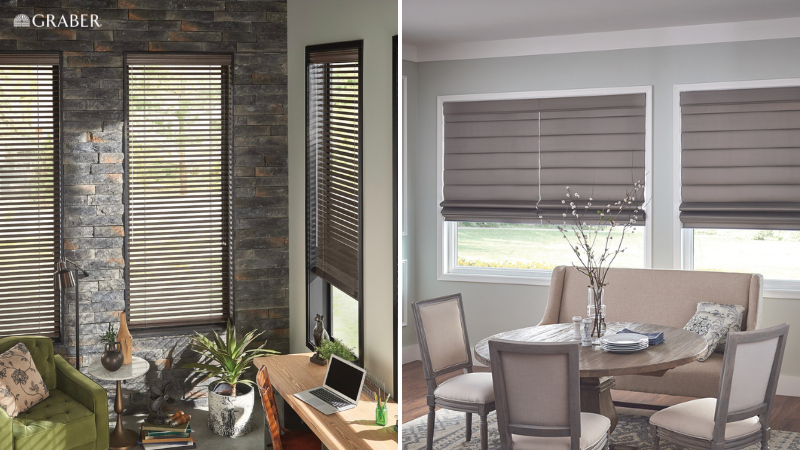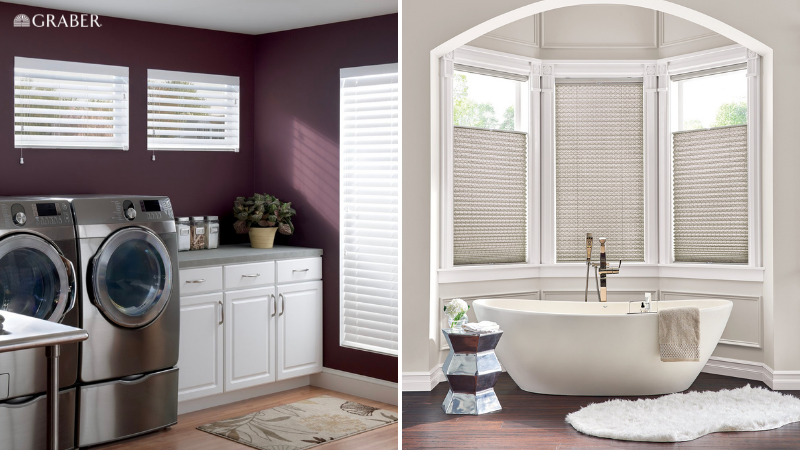Blinds vs. Shades – What’s the Difference?
When it comes to window coverings, there’s a lot of different words that mean different things to different people – blinds vs. shades is one we run into a lot. Plenty of our clients state they’re looking for blinds when what they really mean are shades – or even sometimes drapery (not curtains – we don’t use that word here). While we’re here to help you find your perfect solution regardless of whether or not you know the right wording, it can be helpful to know more about what you’re looking for if you want to do some inspiration searches online before a consultation with us. You may also be wondering the pros and cons of both, and we’ve got you covered!

So what is the difference between blinds vs. shades?
Simply speaking, blinds consist of a window covering composed of individual slats that can be raised and lowered, or tilted to change how much or little light enters your room. Blinds are made of stiffer materials, such as wood, composite wood, aluminum, bamboo, or even vinyl. They can be made with vertical or horizontal slats to cover windows or doors. They’re what we in the industry call a “hard” window treatment.
Shades, on the other hand, are made from a solid piece of softer materials, such as cotton, linen, polyester, woven woods, grasscloth, or even silk. They can even be made out of recycled plastic that’s bee weaved into fabric. Shades are a much larger category, spanning from cellular shades (which many people call cellular blinds), roller and solar shades, to Roman shades, sheer shades, and more. Light control and privacy vary drastically depending on the materials and style you choose. These are called “soft” window treatments since they’re made from fabrics.
How do you decide between blinds vs. shades?
If the difference in materials and functionality isn’t your deciding factor, we’ll explain some of the other differences between the two categories. From light to privacy, cleaning and cost, our job is always to help you find the window covering that best suits your needs, budget, and lifestyle. Let’s break down the different factors we consider when helping you choose:

Light Control & Privacy with Blinds vs. Shades
When you’re looking to control light or give yourself some privacy, there’s definitely differences between blinds and shades.
With blinds, you can open them from top to bottom, or adjust the angle of slats to control the amount of light in your room. The amount of privacy you have will be directly related to how open the blinds are, with no real room in-between. We can have them created with a decorative strip of cloth over the holes where the slats are held in place, which helps prevent light leaking through the small holes. Otherwise the slats and openness of the blinds from the top to the bottom dictate your light and privacy, period.
When it comes to shades, you have way more options. Shades come in a wide variety of opacities, materials, and styles. From solar shades which block UV rays and grant very minimal privacy during the day, to Roman shades with privacy liners that block lots of light as well, you can essentially customize the solution you want.
Sheer shades are another part of the shade family with amazing versatility. While they’re one fabric sewn together, they have two layers of overlapping fabric that create a blinds-like “vane” appearance but of soft, light filtering, UV-blocking materials. Likewise, cellular shades have amazing options to add a sheer material to half the shade and a more opaque material on the lower half. This allows you to change the level of light blocking and even insulation as needed. Whether you’re looking to filter light, significantly darken a room, or guarantee privacy at night, shades are more likely to suit your needs.

Level of Customization with Blinds vs. Shades
Similarly to the above, blinds have lesser customization in general. You can choose a variety of slat sizes. Plenty of stains and paints allow you to choose a style that looks best for your space as well. Vertical blinds are incredibly popular for covering sliding doors or single doors, and have been for decades. Fortunately there are modern versions much more attractive than the old-school vinyl slats as well. You can match your window blinds with door blinds in many cases as well, which is a great benefit.
Shades win, hands down, in terms of customization. There is a huge variety of opacities, fabrics, patterns, colors, styles, and accents you can add to shades. The level of customization varies by product, of course, with Roman shades taking the crown. You can add stripes of ribbon, trim, tassels, and choose the shape at the bottom. When it comes to natural shades, you also have many choices. Made from natural jute, grasses, and bamboo, they have plenty of textural appeal as well as color and style options.
Cellular shades secured at the bottom with brackets to hold tightly to the door are common choices. With shades, you have less flexibility with doors, but they’re doable.
However, there’s one area blinds beat shades, hands down: specialty shaped windows. If you have arches, angles, or other non-rectangular windows, blinds are your best friend. They can be designed to fit a wide variety of unique shapes. Shades really can’t.

Blinds vs. Shades in High Humidity Areas
If you’re looking for window coverings in your bathroom, laundry room, or possibly even your kitchen, humidity matters.
Blinds are the clear winner. Vinyl, faux wood, and aluminum are ideal choices in high humidity areas. They tolerate moisture incredibly well. They won’t build up mildew, warp, crack, chip, or swell. (Faux wood shutters offer the same benefits in these spaces, but this blog isn’t about shutters!)
Shades, on the other hand, are made of fabric. Solar shades and some roller shades will tolerate humidity just fine. In fact Graber’s eco-friendly solar shades are made from recycled ocean plastic. They’ll be just as efficient as vinyl blinds. But things like Roman shades? That’s asking for wrinkling, mildew, weird smells, or even mold. Lightweight fabrics won’t be as big of a deal, but in bathrooms or directly above a sink, they’re not a great idea.
Ease of Cleaning of Blinds vs. Shades
Much like humidity, this is an area blinds tend to beat out shades. Simply put, materials like vinyl, aluminum, and sealed wood can be dusted, wiped with a damp cloth, and mostly need a light dusting for maintenance. You can also run a vacuum over them periodically to ensure they stay looking nice. Spot cleaning is simple on most, and vinyl blinds can even be immersed in water.
Shades, on the other hand, aren’t all so flexible with cleaning. While you can also vacuum the majority of shades, that’s the only option aside from professional cleaning for some higher end materials. Dusting is an option for most (not Roman shades), and very few allow for ultrasonic cleaning. Because they’re fabric, you’re more likely to require professional cleaning for anything other than general upkeep. Even spot-cleaning isn’t recommended for the majority of shades.
We take your lifestyle into account when we help you choose window coverings in person. If you have small children, investing in beautiful shades might need to be limited to your bedroom until the kids are older. If professional cleaning isn’t a deal breaker for you, though, design away however you’d like!
Cost Differences Between Blinds vs. Shades
Cost, unlike many of the other options, isn’t as clear cut when choosing between blinds and shades. There are simply too many factors involved in both to call one significantly cheaper than the other.
Energy Efficiency plays a role when considering cost. Some window coverings with thicker materials or a blackout backing, provide high levels of insulation. Keeping your home’s interior cooler during the summer reduces your energy bills. Cellular shades are pretty much famous for this. The Department of Energy found they can reduce heat gain through your windows by up to 60%! Their air pockets act like a poofy winter coat and trap heat from entering your home.
Adding layers of material also decreases your heat gain in through your windows. Roman shades, especially with an insulating liner, can also be great. Among blinds, only real wood offers much insulation, and even then it’s well below anything offered by most shades. If your windows are in direct sunlight, there are definitely some reasons to opt for specific shades to really make a difference. While we don’t get many really cold days, keeping warmth in with the right shades will help too.
Customization and materials will affect your end-cost too. Solar shades could be significantly less expensive than wood blinds. But highly customized Roman shades may be pricier than any blinds. If cost is a factor, working with a custom window covering company who can help show you options within your budget will help you find your ideal solution.
We hope this has been helpful! Choosing between blinds, shades, or other window coverings isn’t always an easy decision. There are so many factors to take into consideration aside from appearance. If you’re in the Greater LA area, please feel free to schedule a complimentary design consultation with us to help you decide!
